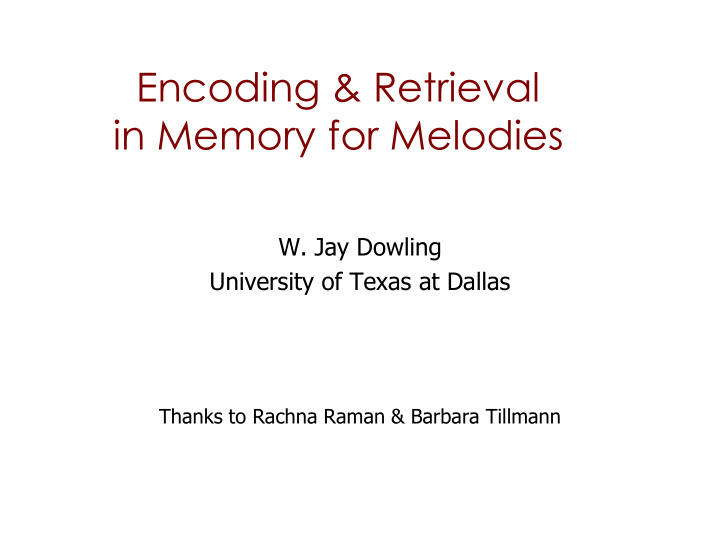



Encoding & Retrieval in Memory for Melodies W. Jay Dowling University of Texas at Dallas Thanks to Rachna Raman & Barbara Tillmann
CONTOUR ▪ Melodic/Rhythmic contour is a strong cue for retrieval of a melody
CONTOUR ▪ The contour is specific to a particular melody ▪ Composers can use contour to allude to another melody – for example, the chorus of Schubert’s Sei mir gegr ű sst refers to the song Bist du bei mir from Bach’s Anna Magdalena Notebook ▪ It is part of what Bharucha (1994) called “veridical” information that pertains to an individual familiar melody
VERIDICAL & SCHEMATIC INFORMATION ▪ Song-specific veridical information is complemented by general schematic information, such the tonal scale embedded in the tonal hierarchy ▪ The tonal scale (in a particular mode such as major or minor) provides the pitch pattern for a family of melodies ▪ Dowling (1978) proposed that melodies are remembered as combinations of veridical (contour) and schematic (scale) information.
MELODY RETRIEVAL ▪ The influence of scale in retrieval can be seen in the task of detecting wrong notes in a familiar melody. ▪ The melody is retrieved to check against the heard melody for wrong notes. ▪ Out-of-key wrong notes are detected rapidly and accurately ▪ Wrong notes 2 ST from their targets are detected better than those 1 ST away, but the gain from violations of expected interval size is not as great as for violations of the scale
MELODY RETRIEVAL
MELODY ENCODING ▪ New melodies are encoded as combinations of contour and scale, but the encoding takes time – of the order of 10-15 sec ▪ Take Beethoven’s Minuet in G:
MELODY ENCODING ▪ Dowling & Tillmann (2001, 2014) presented minuets like this, in which one of the first couple of phrases would be tested later ▪ Here, if the first phrase is a target, it could be tested with a same-contour lure at the third phrase, 4-5 sec later ▪ In that case, the third phrase would be confused with the first, and would produce a false alarm response. ▪ BUT, if we wait for 6 intervening measures (12-15 sec) the confusion disappears, and Ss accept a target and reject the imitation
MELODY ENCODING 90 80 T/S T/S T/D T/D 70 60 50 5 sec 15 sec
MELODY ENCODING ▪ Thus it takes considerable time in the encoding process to bind the contour to the scale ▪ When tested too soon (4 sec) S answers in terms of individual features such as contour (including rhythm) and scales ▪ When tested later, the contour is bound to the scale at the right level, and S can reject the lure ▪ Encoding the melody results in an “object file” in Treisman’s terms
MELODIES WITH OUT-OF-KEY PITCHES ▪ Many melodies, especially from the 19 th century on, contain out-of-key pitches in their familiar form – for example, Schubert’s Ave Maria, or even more extreme, his Sei mir gegr ű sst: j. kii.Bt,,
MELODIES WITH OUT-OF-KEY PITCHES ▪ We familiarized Ss with melodies containing out-of-key notes ▪ We wanted to see what would happen when those notes were altered to be wrong notes ▪ Would they be more noticeable if they remained out-of-key, or if they came back into the key? ▪ We did the experiment twice, with different melodies but the same design ▪ Out-of-key wrong notes were more noticeable
MELODIES WITH OUT-OF-KEY PITCHES
HIGHLY FAMILIAR MELODIES ▪ Post-hoc analyses of previous experiments led us to think that responses to wrong notes in highly familiar melodies differed from those with merely moderately familiar melodies ▪ From recent familiarity ratings we selected 8 highly familiar tunes and 24 that were moderately familiar ▪ We presented these with wrong notes that were in-key vs out-of-key, 1 or 2 ST up or down from their original targets,
HIGHLY FAMILIAR MELODIES
HIGHLY FAMILIAR MELODIES ▪ Expected interval size is much more important with highly familiar than with moderately familiar melodies ▪ This points to the importance of veridical information in the memory representations of these melodies ▪ Which suggests that these melodies serve as a foundation for the pitch pattern of the tonal scale, rather than vice versa
HIGHLY FAMILIAR MELODIES ▪ Practicing scales is characteristic of highly theorized musical cultures such as in Western Europe, India, China, and Japan. In hunter-gatherer cultures people often just learn the songs, but their underlying tonal systems are just as important to the musical structure, and are consistent and highly durable
CONCLUSIONS ▪ Melodies are stored in memory as melodic/rhythmic contours, which are attached to the appropriate tonal scale at the right pitch level in retrieval ▪ The contour and a certain amount of note- to-note pitch interval information constitute veridical information of that melody in memory, whereas the tonal scale is part of the schematic, general information
CONCLUSIONS ▪ During encoding of a new melody it takes time (ca. 10 sec) to bind the contour to the scale at the right pitch level ▪ When a familiar melody has out-of-key pitches, if those pitches are altered to make wrong notes, they are more noticeable when they’re out -of-key than in-key ▪ Alterations in the pitch intervals of highly familiar melodies (veridical information) are very noticeable, unlike with moderately familiar melodies
CONCLUSIONS ▪ This suggests that those melodies form part of the foundation for the schematic information of the tonal scale system
Thank You! Brandon Carter Cynthia Chan Kieth Gryder Kevin Herndon Chris Lo Riya Mahajani Rachna Raman Bhavana Penmetsa Sharvani Reddy Samantha Vorsino
Recommend
More recommend